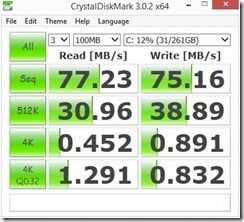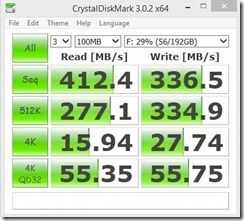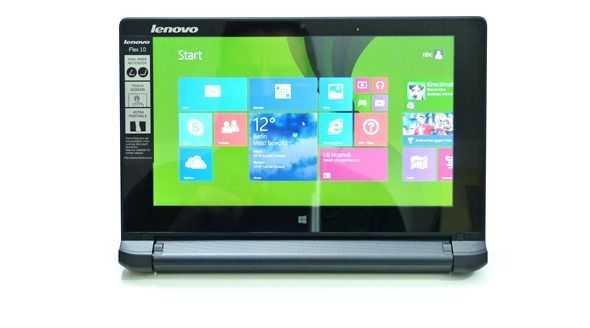We’ve got some great Windows 8 tablets out there with relatively fast SSDs that are costing less than Chromebooks. If you look at the Acer Switch 10 and ASUS Transformer Book T100 you’ve even got a 2-in-1 with touch and SSD at well under $400 but what about a basic Windows laptop, with an SSD? Nope, you won’t find one. Chromebooks dominate with this specification, offer great performance per dollar and they’re selling well. Windows laptops need to do the same.
View all the 8-inch Windows 8 Tablets View all the 10-inch Windows 8 Tablets
I can show you Windows 8 laptops that cost $250 but they’ve all got cheap hard drives inside that cripple the experience. Take this example. I’m testing a Lenovo Ideapad Flex 10 which is a bargain of a touchscreen Windows 8.1 laptop running on Baytrail-M. The 270-degree screen flips round into an entertainment mode, the keyboard is OK, there’s USB3.0 on board and it weighs just 1.2KG but the disk is so incredibly slow that the system is frustrating to use. The first two days of use where just a nightmare of updates, indexing and virus-scanning. Windows 8 needs fast disk access-times and quick 4K R/W figures and as we know, all PC laptops benefit from quieter, cooler, more efficient and more rugged scenarios when they have an SSD inside. Look at these two Crystaldiskmark reports.
The one on the left shows the speed from the built-in 5400 RPM hard drive on the Lenovo Ideapad Flex 10. Look at the 4K read and write figures. They’re terrible and even without using the system it’s easy to see that it’s a bottleneck. Look at the results on the right. It’s a USB3.0 SSD drive (MydigitalSSD OTG) attached to the Flex 10. The USB drive wins by a mile. 30X faster on 4K performance! If I had Windows 8 To Go here, I’d be installing it.
Windows 8 doesn’t need 500GB of hard drive. With cloud storage, streaming and home NAS systems becoming more popular the 32GB or 64GB systems are fine. My daughter has used Office on a Lenovo Miix 2 10 with a cheap eMMC SSD and it’s working smoothly. OneDrive is so well-integrated that when you’re at home you hardly notice that it’s not a local drive.
THERES NO NEED FOR SPINNING HARD DRIVES ON LOW-COST WINDOWS LAPTOPS
Manufacturers need to be re-consider their low-cost Windows designs because Chromebooks are becoming very popular, especially in the USA. Look at the popularity of the cheapest SSD-based Windows 8 tablets too. The ASUS Transformer Book T100 has been in the top-5 best selling laptops at Amazon.com for 5 months now. It’s #1 today. Why not make a simple laptop version of this? Oh, they did. It’s the ASUS K200MA-DS01T and it’s got an 11.6-inch touchscreen and costs $299…but it’s got a 500GB hard drive in it. Is there such a huge difference in price between a 500GB hard drive and a 64GB SSD? Hey, drop the touchscreen if you must but don’t cripple the experience and secure so-so reviews by dropping a slow, noisy and sensitive spinning disk inside your low-cost product.
Chromebooks have their shortcomings but one thing they are doing right is getting a good balance between price, processing power, battery life and SSD speeds. I call for a ban on installing the OS to out-dated spinning hard drives on all low-cost Windows laptops. The Lenovo Flex 10 is a classic example of a good system crippled by a hard drive and if I can find the a sponsor I plan to show you just what a difference an SSD upgrade can make on this device.














I agree with this article but can you *please* differentiate more between a ‘real’ SSD and the soldered eMMC that you get in the bay-trail-T tablets. They’re worlds apart.
Also you must note that the SSDs in chromebooks, while they are the ‘proper’ kind, they are tiiny, typically 16GB. At least these (and the HDD laden budget laptops you bemoan) can be replaced easily.
It does seem about time we get some real 64GB SSDs in as an alternative to the 500GB HDDs (while there are still a lot of people who do want this cheap, large storage), but nothing budget is offering them yet.
The newer eMMC SSDs are good for low cost PCs IMO. Sure, real SSDs in ‘real’ laptops but i’m happy with 10MB/s of read and write at 4K and 150MB/s max TX speed for a casual PC. In the context of this article I’m happy to accept eMMC as the same as SATA SSDs.
Haha Chippy, it’s rare to see you having such rash reaction as “call for a ban on xxx”.
Unfortunately, the consumers buying low cost PCs are usually those who:
– do not have the habbit of housekeeping their local drives. They typically stores tens of HD movies in their PC
– They also typically never knew what an SSD is, or at least never felt the difference.
As soon as they see 64GB, they’ll just think it’s not suitable for their ‘usage’ and move along.
I look at Chromebooks and cheap Windows 8 tablets and think something else. Windows 8 tablets have sold huge numbers. Chromebooks too. Someone is intelligent enough to know that they don’t need so much storage. 3 years ago I would have agreed with you but streaming music and videos,smartphones with 16 or 32GB storage is mainstream now. It’s time for change otherwise customers will continue to be disappointed by the performance of low-cost Windows PCs.
I agree – there’s also the Asus X102 which at first one might think is a laptop version of the T100, but this has a conventional hard drive. Other downsides are poor battery life (apparently 4 hours rather than the T100’s 10-11 hours) and a slower AMD CPU.
To be fair, I disagree there’s no need for large hard drives on laptops – cloud storage is way slower than conventional hard drives, doesn’t work on the tube or many places with poor coverage, and many people don’t have large data allowances (presumably especially those looking for a budget laptop). As for network storage at home, that’s still slower than a conventional hard drive, and isn’t of use when away (the big benefit of an ultra-portable is that it’s mobile and not stuck at home).
But yes, it would be good to have choice – why isn’t there at least one SSD option out there among budget Windows laptops.
The T100 has an option of the best of both worlds – a small SSD and a second larger hard disk (and it’s still only 1.1Kg in weight), so that’s another option that we unfortunately don’t see in low end laptops.
It’s not just budget PCs at fault – even far more expensive ones that could have reasonable sized SSDs for the same price still sell with non-SSDs. Every time someone whines about “Windows being slow” or “PCs take ages to boot”, you can bet there’s a spinning hard disk on their machine.
Dis you make an article complaining about how 5400rpm spindle drives are slower than SSDs? :D
I don’t see how this will affect the sub $300 Win 8 devices, which will mostly if not all be in tablet form factor of 8″ variety. And in that form factor, we are talking about eMMCs, not SSDs. Simply no space for them, not to mention room for added cost in the margins.
But since next den eMMC packages are coming on line from like of Samsung, it should be fine. We won’t be looking at 500MB/s, but we should be getting around 150~200MB/s, which is plenty good (around the same speed as my old X-25 Intel SSDs from 3+ years ago).